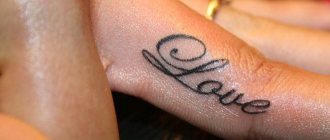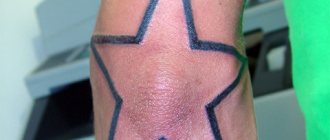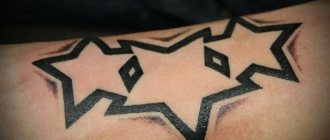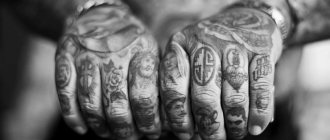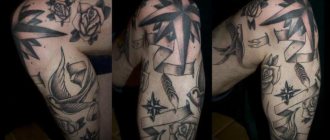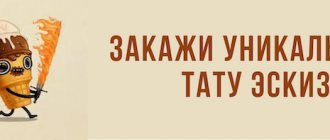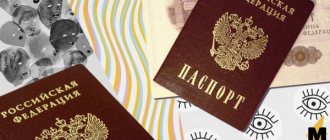Prison tattoos in other countries
The meaning of Zonov’s tattoos is not clear; in different countries, tattoos are treated differently. For example, in the United States, prisoners get tattoos depending on their race.
- Prominent representatives of such a caste are the Aryan Brotherhood, the Ku Klux Klan, and the Nazi rebels from Southern California. All of them are characterized by the application of a swastika, four-leaf clover, three sixes and similar militaristic paraphernalia to the skin.
- In opposition to them, there is a group of African Americans - “Black Power”. They apply tattoos in the form of inscriptions on the back of their hands, knuckles, and African signs as a symbol of respect for their ancestors.
- Latin Americans stand as a separate island between them. These prisoners wear religious tattoos - Jesus, his mother, crosses, rosaries, sometimes biblical scenes or portraits of loved ones.
- And finally, not the most numerous, but no less important group - Asians. They get tattoos depending on their origin: the Japanese - Japanese demons and geishas, the Chinese - dragons.
The Japanese, for example, have a negative attitude towards tattoos. In their opinion, a decent person should not have tattoos. This philistine thinking may be due to the fact that the local mafia (yakuza) could keep entire cities under its control for decades.
Members of the gangster group were, as a rule, completely covered in tattoos. Moreover, family members who were not involved in the criminal business also wore distinctive tattoos. For them, tattoos were a sign of immunity and their origin.
Prison tattoos and their meanings - introduction
The meaning of some tattoos is quite difficult to explain, and some would be better never known, but let’s try.
In this article we will look at photographs of tattoos that I currently have on hand. I can’t know all the meanings of tattoos, because my specialty is artistic tattooing. Therefore, I will not describe everything. If you find an error, write your version in the comments.
At the dealerships you can find a whole collection of symbols for tattoos on discs. Here we will look at some of them. And I wish you never see them in your life
To begin with, it must be said that TANK differs from modern tattoo culture in its primitivism and monochromatic nature.
Although there are masters who still paint real masterpieces, due to prison fashion, the images are usually made in the characteristic blue color. The quality of tattoos also leaves much to be desired in 90% of cases. We usually see rather dull, washed out and disproportionate specimens. LIST OF TANK DESIGNATIONS - quick links
| #Spider in the web | ||
| #mother of God | #tiger | #Rising Sun |
| #cat | #Sailboat | #CAT WITH KEYS |
| #Crucifixion | #Eyes on the chest | #Bells |
| #Eyes on the buttocks | #Lenin and Stalin | #Stars on their knees |
| #swastika | #runes | #ss |
| #sir | #KNIFE IN BARBED WIRE | #rose |
| #mess | #cards | #Bat |
| #bull | #leopard | #Monk writing a book with a pen |
| #KNIFE IN THE NECK | #shackles | #pirate |
| #rose and dagger | #aim | #joker |
| #wolf | #SHA | #gold |
| #scorpion | #LHVS | #Theater masks |
Tattoos in Russian prisons
Zonov's tattoos always carry one meaning or another. These can be images, portraits of loved ones or idols, and they can also include inscriptions that complete the body image.
The following abbreviations are especially popular:
- EVIL - I will take revenge on the cop for everything;
- YUG – young robber;
- PEACE - shooting will correct me;
- TMJ - prison interferes with life;
- NKVD - there is no stronger friendship than thieves;
- KLOT – I swear to love one (one) you (a little romantic).
A few inscriptions:
- “The main thing in the zone is the thief in law”;
- “Killing is not murder”;
- “Born for torment, I don’t need happiness”;
- “I will not forget my own mother” and so on.
"Roosters" in modern prisons
In the adult zone, it is quite difficult to become a “rooster” or a “comb” (what types of omitted ones are there?). To do this, you really need to do something out of the ordinary, and most stories, anecdotes and horror stories are just rumors and if such relics of the past remain somewhere, then they gradually become a thing of the past.
Considerable efforts have been made by prison reform and the prison administration itself to change the situation with the “humiliated”.
Nowadays people are increasingly becoming “roosters” of their own free will . They have not been “carred” by prisoners against their will for a long time, as this is considered lawlessness. Among other things, in order to have sex with a “cock”, you will definitely need to pay him. Naturally, food, cigarettes, tea, etc. can be used as currency.
Moreover, it is very important to pay off the “lost” one, because otherwise, it will be considered that the sex happened out of love, and only someone like himself can love the “lost one”.
The main tasks of the “omitted” person are only to provide intimate services and clean the premises. All of them are divided into those who provide services of this kind and those who simply do dirty work and maybe other humiliating duties. Since they are paid for sex, they increasingly become sex workers of their own free will (this is one of the methods to survive in prison) or after being in prison.
"Cocking" of youngsters
In prisons with juvenile offenders, things are much worse . Here it is easier to be “groomed”, since there are a huge number of different “taboos”, violating which, even out of ignorance, you can get the label “omitted”.
Sometimes even the prisoners themselves don’t know why they can’t perform this or that action, they just know that it’s a “bummer”, which means it’s better not to take risks. For example, it’s a shame to pick up things from the floor, especially cigarettes or a toothbrush.
There are a very large number of taboos associated with food; the forbidden list included chicken, sausage and lard. You cannot pick up fallen soap from the floor in the bathhouse, etc. Naturally, such rules were not observed everywhere before, and even more so now, but in fact they could serve as a reason to “lower” a person.
Most of the prohibitions disappeared with the collapse of the USSR , including the color red, since it was believed that this was the color of the communists, and they were the enemies of the “right boys” and “thieves” in their youth. In those days, it was even a shame to smoke Prima cigarettes, because they came in a red pack.
The “youngster” also has its own prison concepts, but they are quite vague, so they are often “lowered” not even for any offenses, but simply for the sake of entertainment. Most of the “roosters” in the adult zone came there in this status precisely from places of detention for juvenile offenders.
Tattoo ring
A ring tattoo means a lot in the prison hierarchy. Prisoners can fill in such sketches at their own request. But some are forcibly impaled. For example, these could be those who have the lowest rank in prison - a rapist, an informer (image of a dog with the caption “Cop from Presskhata”) or a homosexual (cockerel). The most interesting thing is that even if the prisoner ends up in another prison, his status will remain the same.
A ring is placed on the finger, and the signs inside it indicate the status of the criminal.
- The symbol “denied” characterizes a prisoner who does not come to an agreement with the police; moreover, he is hostile to them. Such a prisoner does not understand those who want to atone for their sins; he will never change. People with such a ring belong to the thieves' elite. It looks like a diamond divided into four parts, and two diagonal triangles are painted black.
- “Muzhik” is awarded to those who have not achieved a certain authority among thieves, but were true to their principles. It is pinned in the shape of a diamond with a black vertical line in the middle.
- A fairly common tattoo that almost all former prisoners have. “Was in prison” – a black square with a white line to the diagonal.
- “On trial for murder” - the handle of a knife is depicted, around which a snake is wrapped.
The meaning of tattoos
1. A half-naked woman in hussar garb, sitting on a cannon with a burning torch in her hand. “There are two beautiful things in the world - love and death.” Symbolizes loyalty to a woman and the hidden threat of revenge for betrayal. Apply to the chest or back.
2. Naked woman tied to a flaming pillar. "Death for treason." Means that the wearer of the tattoo was convicted of murdering a woman. Logs can mean a sentence. Place of tattoo: chest, thigh.
3. Executioner executing naked women. The tattoo is sometimes supplemented with the abbreviation “GOD” (see). Symbolizes hatred of laws and administrative authorities.
4. The Woman and the Devil . “Love and hate (good and evil) are always there.” It means that the owner of the tattoo was imprisoned because of a woman. Apply to the chest or thigh.
5. Woman on wings . The tattoo is small in size and placed on the wrist. Symbolizes good luck, fortune, random luck. Most often found among thieves.
6. A naked woman with a burning torch in her hand, prison bars, a snake, a cross, a human skull, an ax, money. "Nothing lasts forever in this world." "All the will of God". Camp authority tattoo. May be accompanied by a text about the frailty of worldly existence. Apply only to the chest.
7. Fragment of barbed wire . A generalized symbol indicating that the owner of the tattoo has been through a correctional labor institution. Apply to the wrist.
8. Executioner with an axe , half-naked woman, scaffold. The tattoo is found on people convicted of murdering a relative (or relatives). The secondary meaning is “Death to the traitor.” Apply to the chest.
9. Medieval helmet . A symbol of struggle, brotherhood, determination. At first it was applied only to the wrist, but now it is found on the shoulder and thigh. Indicates a thief or robber.
10. Bayonet . The oldest symbol of the thieves' world. Symbolized threat, warning, strength. It was applied to the wrist, forearm, and sometimes to the thigh. The tattoo was common among repeat offenders. Today it is observed extremely rarely.
11. A naked woman crucified on a cross with the inscription " Amen ". “I took full revenge for the betrayal.” An abstract symbol of revenge (not necessarily against a woman). The tattoo is observed among thieves' leaders and is applied to the chest or thigh.
12. Prison bars, rose and dagger . The owner of the tattoo served time for hooliganism in a correctional labor colony. Apply to the forearm or shoulder. If the dagger and rose are without bars - “Blood for treason.”
13. Girl's head . “I met my coming of age at VTC.” The place of the tattoo is the shoulder, less often the chest.
14. Nude woman on a winged wheel. " Wheel of Fortune ". Symbolizes faith in luck. Apply to the chest.
15. A skull pierced by a dagger, a rose, a snake entwining a dagger. Thief symbol. "Our life is a struggle." A crown over a snake indicates a tattoo of a thieves' authority - a thief in law, a ruler, an observer. It is found on the shoulder, less often on the chest.
16. Cross with chain . It is punctured in the upper part of the chest and indicates faith in one’s destiny. If the cross is depicted as a suit of clubs, then the owner of the tattoo is a thief.
17. A naked woman entwined with a snake, with an apple in her hand . Biblical story about the tempting serpent. “A woman pushed her into committing a crime.” "Woman Tempter" Apply to the chest, shoulder. The tattoo is sometimes found among passive homosexuals (usually on the back).
18. Hand with a tulip entwined with barbed wire. “I met 16 years old at VTC.” Place of tattoo: shoulder.
19. Hands in shackles holding a rose. “I met 18 years old at the VTK” (the shackles symbolize a “full-fledged criminal”). Apply to the shoulder.
The last two tattoos are also common among women.
- Catalog : Women's prison tattoos
20. Mermaid at anchor . It is found among sailors and among persons serving sentences for rape or indecent assault. Less common in passive homosexuals. The tattoo is applied to the chest or back.
21. Pitchfork . One of the oldest criminal symbols of Russia. At first it served as a distinctive sign of large raspberries and thieves' authorities. It was left on prison walls, used as a means of communication. Later it began to be applied to the shoulder, thigh or forearm. Symbolizes threat, strength. Now it is rare.
22. Eight-pointed star . Tattoo of camp authorities - thieves in law, denied, godfathers. Apply under the collarbone.
23. Half-naked woman sitting on a magic ball . There is a crescent moon above your head. Symbolizes faith in otherworldly forces. Apply to the chest or back. Found among Muslims and Jews.
24. Bear holding a medieval ax with an image of a suit of clubs. Indicates a safecracker - a burglar. It may also mean that the convict served his sentence at a “logging camp” - in a correctional facility specializing in logging. “The law is the taiga, the ladle is the norm, the bear is the prosecutor.”
25. Crossed arrow and key . Symbol of an apartment thief - a burglar. Apply to the forearm or thigh.
26. A woman with bare breasts and an index finger pressed to her lips. "Silentium!" - “ Silence !” Symbolizes distrust of a woman. “As long as there are women in the world, there will be no secrets.” Apply to the chest.
27. Star of David entwined with a winged snake. The owner of the tattoo is a Jew and belongs to the winged camp authorities.
28. Saber without scabbard . The tattoo symbolizes aggressiveness and secret threat. Apply to the forearm and wrist. A saber in a sheath means that the criminal is “tied up.” Very rare.
29. Inscription Hoc est in votis . “Don’t love money - they’ll ruin you, don’t love women - they’ll deceive you, but love God (or freedom).”
30. Woman, gun, money, bottle, syringe, knife, cards . “This is what we love” or “This is what destroys us.” Symbolizes wild life, wastefulness.
31. A lion surrounded by medieval weapons - a sword, an ax, a bow, arrows, a mace. Symbolizes strength and power. A book lying in front of a lion signifies wisdom. "Cruel, but fair." Authority tattoo. It is almost always applied to the chest.
32. Flying demon . The picture can be supplemented with the inscription “Fatum” (rock). Applied to the chest and means cruelty. "My god is an evil Demon." “Satan will pay for your sins.” Found in bulls, fighters, denied.
33 and 34. Tattoos of drug addicts. A genie flying out of a jug. Apply to the chest, shoulder or front of the thigh. A spider in its web may pierce the scalp under the hair. A spider without a web means a pickpocket.
35. Three cards pierced by an arrow. The badge of a card sharper.
36. Eagle on top of the mountain. Symbol of power and freedom. Tattoo of camp authorities.
37. Damn . The tattoo belongs to the so-called “grins” and symbolizes hatred of administrative structures. Apply to the chest. Accompanied by anti-state texts.
38. Cupid with a bow, a tempting serpent, doves, a heart pierced by an arrow. Artistic tattoo. "Tempted by you forever." Apply to the chest or back.
39. Dragon flying over the castle. Tattoos are found among plunderers of state or collective property, “guild workers.” It also means complete confiscation of property. Apply to the chest and back.
40. “ CAT is the original inhabitant of the prison .” The image of a cat is painted by repeat offenders who compare themselves to this animal. A cat combines pride and affection for home (a thief's home is a prison). The drawing can be accompanied by texts like “And here I am at home.”
41. Symbol of the power of the pharaoh . At first I met only with camp authorities. Then the tattoo began to be tattooed by thieves who resell stolen items. Now it is rare. Applied to hands.
42. Burning crucifix with a woman. “A woman pushed her into committing a crime.” “I will take revenge for betrayal.” "Convicted of murdering a woman."
43. Running deer . "I was born free and I will die free." Applied to the chest and indicates a tendency to escape.
44. Knights . "Strength and loyalty." Apply to the chest.
45. A cowboy with a naked girl on a horse. The drawing may be accompanied by the abbreviation “OMUT” (“It’s hard to leave me”). It means a propensity for risk and adventure. The tattoo is applied to the chest.
46. “ Cowgirle ” - cowboy girl. “The world is ruled by gold and audacity.” Common among malicious violators of camp regulations.
47. Woman, rose, dagger . "Revenge for betrayal." Place of tattoo: forearm.
48. A woman with a sword, stringing hearts. "She broke the heart". " Heartbreaker ". The tattoo is dedicated to the lady of the heart and is applied to the chest or thigh. Also found in women. The number of hearts indicates the number of men conquered.
49. A woman in a horseshoe entwined with barbed wire. “I owe the prison to a woman.”
50. Hand in shackles , clutching a knife. “A hand to the thief, a knife to the prosecutor.” “Execution will correct me.” Symbolizes cruelty and violence. The tattoo is found among deniers, godfathers.
51. Cross engulfed in flames, with the inscription “Believe in God, not communism.” Political tattoo. As a rule, it was applied by political prisoners (see the chapter “Political tattoos”).
52. “ This is what’s left of us .” The owner of the tattoo spent years in prisons and camps (the number of barbs on the wire may indicate his length of correctional labor). The secondary meaning of the tattoo is “I will take revenge on the cops for everything.” Found on the chest and back.
53. A prisoner crying behind bars . “Cursed be the one from century to century who decided to correct a person with prison.” Apply to the chest or back. Like the previous tattoo, it indicates a camp old-timer.
54. “ Well, cop, wait a minute!” » Caricature of a police officer. Often the wolf is depicted in a uniform cap, jacket and sword belt. Apply to the thigh and lower back.
55. Dancing skeletons . Symbolizes risk, fearlessness, contempt for death. The tattoo first appeared in Mexico and was “imported” to the Soviet Union in the 60s. The place of tattooing is the shoulder or chest.
56. Neptune . Strength and authority. “Pity for a person humiliates a thief.” The drawing is also found among sailors.
57. Indian . "Deprived of civil rights." Similar tattoos were applied by political prisoners and dissidents.
58. Sailboat . "The Eternal Vagabond" or "The Eternal Wanderer." Points to the guest performer. White sails mean a thief, black sails mean a gopnik. Sometimes the number of masts indicates the number of convictions. Apply to the chest and thigh.
59. Fighting bulls . "Who is stronger is right". Symbolizes aggression, the struggle for power. Inflicted by camp authorities. The drawing may be accompanied by text. Place of tattoo: chest.
60. Tiger head . "Cruelty and rage." The tattoo bearers are bulls and fighters (persons who commit physical violence on the orders of a thief in law). Found on the chest and shoulder.
61. Latin letter “D” , tiger holding a skull in its paw, crown, suit of spades. Symbolizes violence. The tattoo is typical for Gopniks.
62. Gladiator . Inflicted by bulls and fighters. Most often - on the chest. Blood may drip from the sword, which indicates a fighter with “experience.”
63. Pirate with a knife in his teeth. The knife has the inscription “IRA” (“I’m going to kill activists”). The tattoo is found in the denied person. The camp asset is the Internal Order Service (“IPS”). Denialists call this service “The bitch went out for a walk” and “The bitch went out for half” (early release).
64. Hands in shackles , clutching the cross with the crucifixion of Jesus Christ. Symbolizes faith in the brotherhood of thieves, devotion to the thieves' business.
65. Monk with a goose feather. Indicates a “scribe” - a pickpocket who commits thefts using sharp objects - a razor, coins, rings.
66. Eagle with a suitcase in its talons. Means a guest performer. If a woman is in the clutches - “Convicted of rape.” A tattoo may indicate a tendency to escape.
67. Woman with a snake around her neck. Implies cruelty and violence. Found among eastern peoples.
68. Napoleon . A symbol of power and adventurism.
69. Beetle . “I wish you a successful theft.” Pickpocket tattoo. It is applied between the thumb and index finger. Instead of a beetle, a spider without a web or a flea can be depicted.
70. Hand with a dagger piercing the devil. Tattoo of anti-Semites. “Beat the Jews, save Russia!”, “The murder of a Jew is not a crime, but the cleansing of the world from the messengers of Satan.” Such tattoos were considered political and were destroyed.
71. Devil with a bag . “There was happiness, but the devil took it away.” The owner of the tattoo has extensive experience as a thief.
72. Woman with bare breasts. On the chest there is an amulet in the form of the letter “M” and a crown. " Revenge for Betrayal ." Symbolizes aggressiveness, violence, cruelty.
73. Weeping Muse . The tattoo symbolizes wandering, unrecognized talent, disappointment. Also found in women.
74. Griffin . "Keeper of Secrets" Distributed among eastern peoples.
75. North - “Served his sentence in the North.”
76. An eagle between two trees of different climate zones. Denotes a touring thief and a tendency to escape. The skull in claws symbolizes violence.
A.V.Kuchinsky
Other Zonov tattoos
In addition to rings, inscriptions, and abbreviations, prisoners also stuff images that contain deep meaning.
- A tattoo of shackles means that their wearer is serving a sentence of more than five years on a serious charge. Each ring on the shackles corresponds to a year of imprisonment.
- The devil tattoo symbolizes fearlessness and an irrepressible desire to survive in any situation. The demon sitting on the moon suggests that a person will not lose heart even in the most lost situation (he will even find a way out of space).
- However, a tattoo of a devil undressing a woman or a devil doing the same thing can mean a despondent prisoner.
- The devil, stuffed all over his back, characterizes a person who has a certain thieves' authority in places of serving his sentence. The convict wants to show his cunning and insidiousness.
There are also moments when a prisoner realizes the gravity of his crime and repents. Then he can get a tattoo of a crying killer.
Who are the omitted ones and are they marked?
“Dismissed” are either homosexuals or those who were lowered into their ranks for offenses (non-payment of debt, theft from cellmates).
Representatives of the lower caste among prisoners are often marked with appropriate tattoos, most often this happens by force.
This is done mainly in order to distinguish people, because the “lowered” ones cannot be touched (they are even beaten with additional objects, not fists), or shared with them.
Read more about who the omitted ones are and how not to become a “rooster” in the zone, read more about the types of omitted ones in this material.
Methods of tattooing
Thanks to the strict regime in places of deprivation of liberty, the methods of applying tattoos amaze the imagination with their sophistication. All tattoos are done exclusively by hand and with means that the average person does not attach importance to.
As a rule, needles are used on sticks or on matches. They are dipped in ink and precisely pierced into the skin. If there are no needles, then cunning prisoners can use wires or any other thin objects from which a point can be sharpened. Well, if there is no ink or ink, mix a paste of soot and sugar diluted in urine or water.
Sometimes teenagers can apply tattoos to themselves “out of naivety”, without suspecting their true meaning, since outside the criminal environment their subject matter is considered completely harmless. Sometimes future prisoners may tattoo themselves in advance, hoping for honor or at least a quiet existence in the prison world. But this rarely really helps.
Prison tattoos and their meaning - continued
The crucifix means that its owner is a crime boss.
Eyes on the chest - stands for “Looking for bitches” in the jargon.
Tattooing a Bell means that the owner of the tattoo has served his entire sentence “from bell to bell.”
The eyes on the buttocks - its owner, belongs to the lowest caste of prisoners, drooping.
The Lenin and Stalin tattoo on the chest serves as protection from security officer bullets. Bandits in the USSR believed that the security officers would not shoot at the image of the leaders. Now he is being pinned up by ordinary people for banter.
Lenin is also a symbol of a thief. VOR - Leader of the October Revolution.
Stars on their knees mean that the owner will not kneel before the law.
Who can get epaulets tattooed?
Since ancient times, people have decorated their bodies with various tattoos. Patterns on the body could tell a lot about a person: where he comes from, what he does, his social status, etc. In the 20th century, tattoos became the prerogative of prisoners. Using them, prisoners “read” the history of those new to the zone.
The fact is that epaulets are the most controversial tattoo in the world of thieves. Shoulder straps are worn by military and police officers - the main enemies of prisoners. But at the same time, only thieves, whose authority is not subject to the slightest doubt, can get such a tattoo.
The thieves' stars on their shoulder straps can tell you how many walks the prisoner had.
Also, such a tattoo can be made for those who served time in a maximum security colony. Ordinary prisoners are prohibited from getting tattoos of shoulder straps - this can lead to forced correction of the design with homemade machines or even cutting off a piece of skin with the image applied.
Putting an image of shoulder straps on your body is a big responsibility, for which you will have to answer harshly, according to prison laws.
This type of tattoo is rare among juvenile criminals - they lack experience and authority. An exception is made only for those who spent more than 50 days in a punishment cell: in this case, the right to shoulder straps appears.
